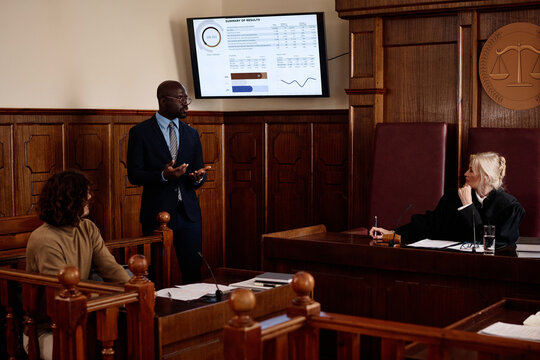Navigating Complex Instances: How to Develop Efficient Trial Presentations for Optimal Outcomes
Navigating Complex Instances: How to Develop Efficient Trial Presentations for Optimal Outcomes
Blog Article
Exactly How to Create Involving Test Discussions That Sway Juries and Judges
Crafting engaging trial discussions that mesmerize juries and judges is a nuanced art that needs a strategic strategy. By utilizing cutting-edge aesthetic tools, including interactive elements, and dedicating time to strenuous method and rehearsal, lawful experts can considerably improve the effect of their court room presentations.
Recognizing Your Audience
To properly engage your audience during test presentations, it is critical to comprehend their choices, assumptions, and degree of competence in the topic. By tailoring your discussion to fulfill the specific needs of the target market, you can boost their understanding and retention of the information presented.
Begin by investigating the demographics of the audience, such as age, education degree, and line of work. This information can help you gauge their familiarity with legal treatments and adjust your presentation design accordingly. A jury may need less complex language and more aesthetic help compared to a group of lawful professionals.
Additionally, consider the psychological and emotional facets of your target market. Are they thoughtful in the direction of specific arguments or even more likely towards realities and proof? Comprehending these subtleties can aid you mount your presentation in a means that resonates with the target market on a deeper degree.
Narration Strategies
Comprehending your target market's expectations and choices can significantly influence the performance of your test discussions, particularly when executing narration methods to mesmerize and persuade. Storytelling is a powerful tool that can assist attorneys link with judges and courts on a more emotional level, making complex lawful debates more relatable and memorable.

Incorporating vibrant information, personal stories, and ornate devices can further improve the storytelling experience, keeping the audience involved and spent in the end result of the case. By crafting a convincing tale that reverberates with the values and emotions of the court and judges, attorneys can boost the chances of winning their debates and achieving desirable judgments.
Aesthetic Presentation Devices
Making use of visual discussion devices can significantly boost the impact and efficiency of test presentations by providing an aesthetically appealing method to communicate intricate information to juries and courts. Aesthetic help such as graphes, charts, computer animations, and representations can aid streamline complex details, making them a lot more understandable and easily accessible to the target market. By incorporating aesthetic aspects into test presentations, attorneys can create a compelling story that resonates with jurors and leaves a long lasting impression.

Incorporating Interactive Aspects
Incorporating interactive components right into test presentations can improve target market involvement and understanding, promoting a more immersive and interactive courtroom experience. By incorporating components such as interactive timelines, 3D animations, clickable exhibits, and virtual truth repairs, legal experts can astound judges and jurors, making complex info a lot more remarkable and easily accessible.
Interactive timelines permit a vibrant screen of sequential events, aiding the target market understand the series of crucial occurrences in a case. 3D computer animations can bring criminal activity scenes or accident reconstructions to life, supplying an in-depth visual representation that aids in clearing up intricate details. Clickable exhibits allow users to communicate with evidence, papers, or images, permitting for a hands-on exploration of essential information.
Additionally, online truth restorations can transfer the audience right into the heart of the action, providing an engaging point of view that conventional discussions may lack. These interactive aspects not only involve the viewers but also empower them to actively take part in the trial proceedings, bring about a more influential and impactful court discussion.
Practice and Rehearsal
To successfully leverage the capacity of interactive elements in trial discussions, detailed method and wedding rehearsal are important to ensure seamless assimilation and delivery in the court setting. Technique and rehearsal help trial presenters come to be aware of the web content, timing, and flow of their discussions, allowing them to confidently navigate via different aspects such as videos, computer animations, or interactive graphics. By rehearsing their distribution, presenters can fine-tune their speaking skills, body language, and overall presentation style to boost persuasion and integrity before the jury and court.
During session, presenters can determine any kind of technological problems that may occur with interactive components, making certain that every little thing runs smoothly throughout the real trial. Additionally, practicing in front of a mock audience or associates can offer important responses on the performance of the interactive elements and go now the general presentation. This feedback permits presenters to make needed changes and renovations prior to tipping right into the courtroom, inevitably boosting the influence and success of their trial discussions.
Conclusion
Finally, creating appealing test presentations that mesmerize juries and courts calls for a deep understanding of the audience, effective narration methods, visual devices, interactive aspects, More about the author and extensive technique (Trial Presentations). By carrying out these approaches, attorneys can properly communicate their disagreements and evidence in an engaging way that resonates with the decision-makers in the court room
Using visual presentation tools can greatly boost the effect and effectiveness of trial discussions by giving a visually engaging method to share complex information to juries and courts. By including aesthetic components right into test presentations, legal representatives can create an engaging narrative that resonates with jurors and leaves a lasting impression.
One preferred visual discussion tool is the use of multimedia presentations, which enable for the assimilation of video clips, pictures, and audio recordings to supplement verbal arguments. Trial Presentations.To effectively leverage the potential of interactive aspects in trial discussions, detailed method and practice session are crucial to guarantee seamless assimilation and shipment in the courtroom setting. Technique and wedding rehearsal assistance test presenters end up being acquainted with the content, timing, and circulation of their presentations, permitting them to confidently navigate through various components such as videos, animations, or interactive graphics
Report this page